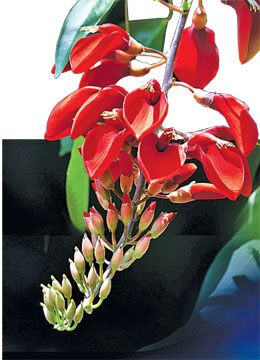 New Year is here again! New Year is here again!
By Kalakeerthi EDWIN ARIYADASA
“The sun and stars that float in the open air;
The apple-shaped earth, and we upon it - surely the drift of them is
something grand!
I do not know what it is, except that it is grand!
and that it is happiness.”
- US poet Walt Whitman (1819 – 1892)
Let us all rejoice.
New Year is here again.
Days of joy and happiness are just round the corner.
Time for ardour - Time for feasting -
Time for reunion. It is all here.
Reading the lines above, one may very well wonder why on earth there
should be such an effusive gush over a routine annual event. What has
brought on this fresh flood of enthusiasm for an age-old ritual?
I will explain.
In the recent past, our society has continued to display a steady
alienation from our wholesome traditional practices. A prominent victim
of this distressful negligence is the New Year Festival. Year after
year, our collective zeal and fervour for New Year celebrations have
perceptibly declined.
Over the past few years, commercial interests, electronic media and
print media have effectively prodded the masses awake to the need to
celebrate New Year. Our religious centres - temples and monasteries -
have continued to provide perennial guidance to their communities in the
proper performance of the rites and rituals linked to the New Year
celebrations.
 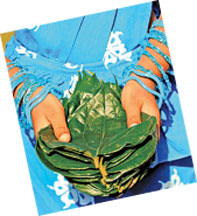 With all that, mass passion for New Year celebrations has been
clearly on the wane. The profound pleasure of the New Year family
reunion has vastly dwindled due to rapid transit. The endless agendas of
the modern generations, their hurry and urgency do not allow them
sufficient soul space to savour the keen human delights of the New Year
festivities. Why I waxed enthusiastic at the beginning of this essay is
because even under those restraints, New Year is here again. With all that, mass passion for New Year celebrations has been
clearly on the wane. The profound pleasure of the New Year family
reunion has vastly dwindled due to rapid transit. The endless agendas of
the modern generations, their hurry and urgency do not allow them
sufficient soul space to savour the keen human delights of the New Year
festivities. Why I waxed enthusiastic at the beginning of this essay is
because even under those restraints, New Year is here again.
Visual announcement
One will find it extremely difficult to appreciate fully the joys of
New Year celebrations, unless one enjoyed a rural childhood that
resonated to the aura of the New Year festival. The village gets ready
for the New Year, months ahead of the event. The deep red buds of the
Erabadu tree are nature's colourful visual 'commercial' to announce that
the New Year will be with us soon. The sweet warblings of the cuckoo add
a compelling soundtrack to the 'visual'.
The life of the rural community is overwhelmed by the preparations to
greet the 'New Year Prince'. The details they focus on are astonishing.
To quiten the troubling fruit-fly, they employ a ruse. They have a rice
cake (keuma) to attract the fruit-fly, to prevent the insect from
harassing humans. The village community is astir - individually and
collectively - to celebrate this festival, which assumes prime stature
in the national calendar.
Traditionally New Year festivities are held on April 12, 13 or 14
every year. The auspicious hours are calculated in terms of traditional
dicta. Traditional astrology assumed that the sun “travels” from the
Zodiacal sign of Pisces to the Zodiacal sign of Aries, ushering in the
New Year.
This belief must certainly amuse the modern generations. For us, it
is axiomatic that our Planet Earth orbits the Sun, in a non-stop
celestial routine. This space drama has gone on for billions of years.
Our home, Planet Earth and those of us who inhabit it keep on orbiting
the Sun. However, the traditional belief is so thoroughly entrenched,
that we arrange our New Year celebrations on the assumption that New
Year begins with the transit of the Sun from Pisces (Meena) to Aries
(Mesha).
Oldest festival
It must be stressed that as much as the New Year festival is our
foremost celebration, it is mankind's oldest festival too. In man's
earliest days on Earth, he was intimately linked with the processes of
nature. The veering seasons dominated his cycle of existence. Nature was
at its brilliant best in Spring. Clad in green, nature smiled. Streams
gurgled along. Song-birds warbled their rapture. Summer embraced them,
nourishing them with its sumptuous fertility.
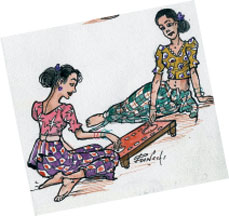 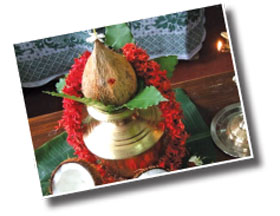 Autumn came along. The falling leaves saddened the people, with a
hint of decay. Winter reduced the ancient human into utter helplessness. Autumn came along. The falling leaves saddened the people, with a
hint of decay. Winter reduced the ancient human into utter helplessness.
He was devastated that the God of Nature was dead. People wailed and
wept. In early human cultures, the ancients wept, wailed and lamented in
actuality. They went about mourning. This loss of the nature-god's power
was ritualised by ancients in exotic ways. In some villages in Ireland,
the womenfolk tie up strong young men with ropes, to symbolise the
nature-god's loss of power, but untie them after a while.
Lo and behold, to the utmost joy of the ancients, the ‘dead’ god
begins to stir awake in Spring. Early man greeted this new life with
joyous celebrations. In almost all new year rituals and celebrations,
this process is present - sadness followed by joy.
In Sri Lanka's New Year celebrations too, these two primordial phases
are very much present. Unfortunately, many have not been able to
penetrate this anthropological evolution. In our celebrations, we have
the Old Year and the New Year.
Neutral hour
The Old Year signifies the 'death of god'. The indigenous term
“Nonagathe” really implies the neutral hour. This is the hour when the
Nature-God is without life. In our sadness, we refrain from kindling the
hearth. We do not eat or drink. We resort to meritorious deeds and
spiritual activities.
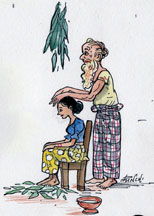 At the end of the Old Year (at the conclusion of Nonagathe), the
“dead” God re-awakens with life. We rejoice with his new life. Hearths
are rekindled. Feasts are held. Relatives and friends exchange visits.
We begin life anew with the newly risen god. At the end of the Old Year (at the conclusion of Nonagathe), the
“dead” God re-awakens with life. We rejoice with his new life. Hearths
are rekindled. Feasts are held. Relatives and friends exchange visits.
We begin life anew with the newly risen god.
We start transactions afresh. We begin our livelihoods. The whole
meaning of the New Year celebrations will come home satisfactorily if we
appreciated the ancient roots of this wholesome celebration. The
celebration unifies the community - by making it necessary for the
entire community to initiate rituals at a stipulated moment.
Once the profound significance of the New Year celebrations is fully
understood, we can bring the people back to observe the New Year as an
important segment of our indigenous culture.
The alienation from our great cultural legacy is largely due to the
hiatus in our awareness of what the indigenous way of life could
contribute towards our enrichment.
|

